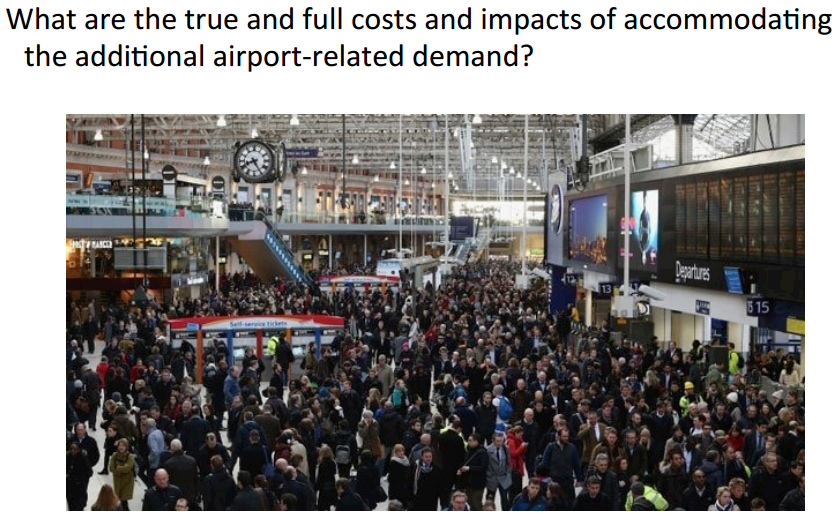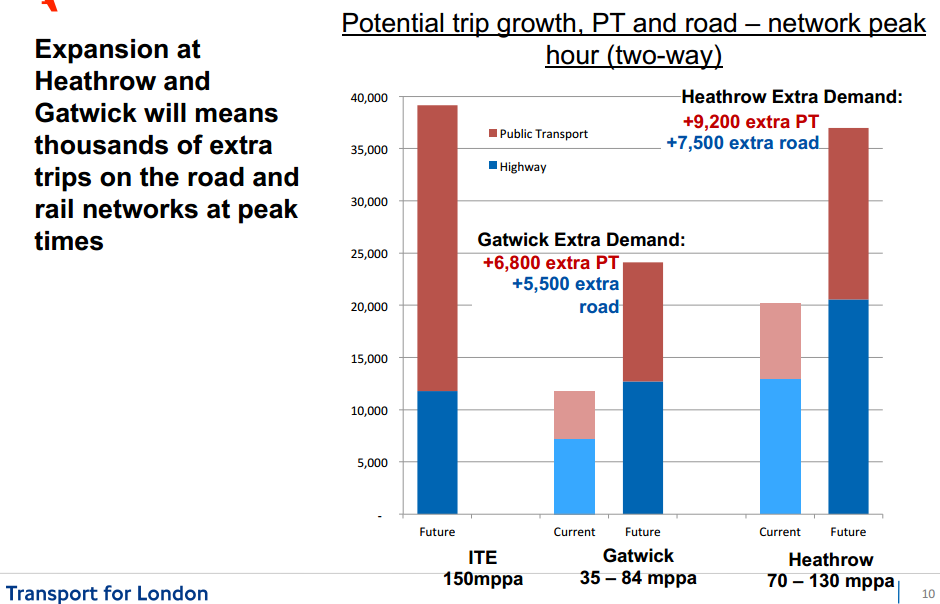Road and rail chaos, with congestion and over-crowding, predicted if new Gatwick runway built
A new research paper prepared by author and environmental expert Jeremy Early, on Surface access to Gatwick Airport predicts that a new runway at Gatwick would bring road and rail chaos. He points out that the existing road structure is nearly full, with serious delays occurring on many routes, especially on the M23 and A23 into London. Planned improvements will only be sufficient to deal with the forecast growth in traffic – without a new runway. A new runway, operating at full capacity of 95 million passengers a year, would mean an a massive increase in road traffic movements each day. It would probably reduce the M25 and M23 to a standstill – all day not just occasionally. On rail, the report shows that already between 2010 and 2014 rail journeys in the South-East increased more than 20%. The extra trains that Gatwick airport boasts of are in reality already just to cope with the expected increase in demand – with no new runway. With a new runway Gatwick predict a three-fold increase in the number of air passengers using Gatwick station. It could be standing room only, with no spare capacity on parts of the network.
.
Tweet
Road and rail chaos predicted if new Gatwick runway built
20.10.2014 (GACC – Gatwick Area Conservation Campaign)
A new research paper prepared by author and environmental expert Jeremy Early Surface_access_to_Gatwick_Airport_October_2014) predicts that a new runway at Gatwick would bring road and rail chaos.
Jeremy Early points out that the existing road structure is nearly full, with serious delays
occurring on many routes, especially on the M23 and A23 into London. Planned
improvements, such as hard shoulder running on the M25 will only be sufficient to deal
with the forecast growth in traffic – without a new runway.
A new runway, operating at full capacity of 95 million passengers a year, would mean an
average 56,000 more road traffic movements a day (more in summer). On top of that,
journeys by Gatwick staff, and journeys by workers at new firms attracted to the area, are
forecast to mean an extra 64,000 cars and buses on the road – bringing the total to over
120,000 extra vehicles every day.
Brendon Sewill, chairman of GACC, says: ‘This colossal increase would be bound to reduce the M25 and M23 to a standstill – all day not just sometimes! And for a large area around Gatwick it would cause chaos on both on A roads and minor roads with traffic jams at many road junctions so that travel to work would take longer and become much more
stressful.’
Problems on the trains
Similar problems are forecast for rail travel. Already between 2010 and 2014 rail journeys
in the South-East have increased more than 20%. (1)
Gatwick Airport Ltd are boasting that there will be six extra trains an hour – but in fact these are already scheduled to come into service in 2017 to cope with the expected increase in demand – with no new runway.
With a new runway Gatwick predict a three-fold increase in the number of air passengers
using Gatwick station.On top of that it is claimed that one in five employees at the airport and in new local firms will use rail services. That would bring the total up to over 110,000 extra passengers a day using the trains.
The airport has claimed that extra trains will run to London, and that the length of trains
will be increased. But as Early points out, the new Thameslink trains on order are
designed to carry more passengers standing than sitting. ‘So it will be standing room only
– pity the poor commuters!’
Moreover no solution has been put forward to the bottleneck at East Croydon. Steve
Knight, Network Rail area director for Sussex, said this week: ‘We are fast approaching the
point where there simply isn’t any more space for more trains on the busiest parts of the
network’. (2)
Brendon Sewill added: ‘Last time a plan was put forward for a new runway at Gatwick (in 2003) the Department for Transport reckoned that a long tunnel might be needed under East Croydon. (3)
We will see soon whether the Airports Commission come to a similar conclusion.’
.
The report:
“Surface access to London Gatwick Airport: present problems and future nightmares” by Jeremy Early, October 2014.
For a biography of Jeremy Early see
http://www.natureconservationimaging.com/Pages/nature_conservation_imaging_biograp
hy.htm
.
(1). 2014-15 Quarter 1 Statistical Release. Passenger Rail Usage. Office of Rail Regulation. October 2014
(2). Quoted in The Argus. 18 October 2014
(3). The Future Development of Air Transport: South East. Second edition. Department for Transport. 2003
.
.
By contrast, see the exaggerated claims made by Gatwick airport:
Gatwick claims that with better public transport it will be “road & rail ready” for 2nd runway by 2021
Gatwick has produced a glossy document setting out how it will have fantastic road and rail links in place by 2021, that there will be no road or rail congestion, and everyone will have smoother and easier journeys. And at no cost to anyone. There are some stunning omissions. Most things that are inconvenient are just left out. They say “Gatwick will increase the cost efficiency in the rail industry by filling off-peak trains as well as providing passengers for trains operating in the opposite direction to peak commuter services. While it is estimated that, on the busiest trains, only 5% of travellers will be air passengers, the overall benefit they will bring will be around £3 billion in additional fare income.” Gatwick says: “Junction 9 of the M23 … will need to be upgraded to cater for expansion. Gatwick has committed to funding a doubling of this motorway junction capacity.” The only thing Gatwick has said it will pay for. Also: “we have re-designed the local road network to be no busier than it is today, even after a general increase in demand, which will lessen local noise and air quality effects of background traffic, benefit economic activity and the quality of life of those using and living along the affected roads.” Really? Who writes this stuff?
.

. A slide from Michele Dix’s (from TfL) presentation Link

And another slide from Michele Dix, indicating the extra pressure on surface transport, at peak times, from another runway being allowed at Heathrow or Gatwick Link
.
See also
Heathrow and Gatwick set out their rival claims at RunwaysUK conference on airport surface access
The organisation, RunwaysUK, which describes itself as a neutral platform for debate on the rival runway schemes, held an interesting and productive half day conference on surface access to airports. There were accounts by Heathrow, Gatwick, Heathrow Hub and the Thames estuary scheme proposers of their plans for road and rail access, as well as contributions by TfL, Network Rail and others with an interest. It is recognised that adding a runway in the south east would come with immense transport strains on existing transport infrastructure. In order to meet requirements on the amount of passengers (and staff) using the airport to be by public transport, the airports know they cannot depend on road access alone. The pressure of extra passengers on networks that are already stretched, especially at peak times, is recognised – though Gatwick and Heathrow do their best to say their passengers will add little, and merely make rail services more profitable out of peak hours. Vexed issues remain of how much the taxpayer pays for transport services the airports benefit from, and what the cost of added congestion to road and rail services – from millions of extra air passengers being added – would cost the economy.
Click here to view full story…
.
See also:
Gatwick hopes its claim will be believed that area’s road network will ‘better than or the same’ with 2nd runway
Gatwick airport’s publicity machine is saying the area’s road network would be left ‘better than or the same’ if a second runway was built at Gatwick. It is claiming its planned infrastructure improvements will make it ‘road and rail ready’ by 2021 for a new runway. And “with no additional cost to the taxpayer.” They want to “create a regional transport hub to help drive economic growth across the entire area.” Works on a new junction on the A24 are due to start now and could last 18 months, while roadworks have been ongoing on the A23 near Handcross since 2011. Gatwick’s spokesman, Hugh Sumner, said of the local road network’s ability to cope with any additional strain: “Our commitment is we are going to leave the road systems working better than or the same in 2050.” But the Gatwick Area Conservation Campaign (GACC), which opposes a 2nd runway, questioned the contents of the transport document. Brendon Sewill, chair of GACC, said: “The document published by [Gatwick Airport Limited] contains 10% inaccuracies, 20% inconsistencies, and 50% wishful thinking.” TfL appreciate the huge strain a new Gatwick runway will place on surface transport networks, which Gatwick is attempting to gloss over.
https://www.airportwatch.org.uk/?p=21833
.
Level playing field on transport costs vital to proper assessment of runway options – says TfL
10.6.2014
By contrast to the Gatwick spin, above, figures from Transport for London (TfL) paint a different picture. The issue of surface access to airports was the subject of the RunwaysUK conference on 2nd June. Michèle Dix, planning director of Transport for London, said that the costs for surface access for each of the runway options must be assessed against a level playing field of criteria.
Michèle said it was vital that estimates by runway promoters reflected that actual needs of transport in the capital. “You need to compare like with like. What are the true and full costs of accommodating this additional demand? If airports are placing a greater demand on the network then we need a greater transport provision.”
TfL predictions are that the extra demand, due to Gatwick, at peak times (per hour) would be 6,800 extra using public transport, and 5,500 extra by road if Gatwick filled a second runway The extra demand, due to Heathrow, at peak times would be 9,200 extra using public transport and 7,500 extra by road if Heathrow filled a 3rd runway.
TfL estimated that comparable “optimal” investment level of investment needed – the total package of transport schemes required to deliver an optimal level of surface transport access – for Heathrow was £17.6bn, Gatwick £12.4bn (and an Inner Thames Estuary airport £19.1bn). 10.6.2014
https://www.airportwatch.org.uk/?p=21781
.
.
.
.
.
.
